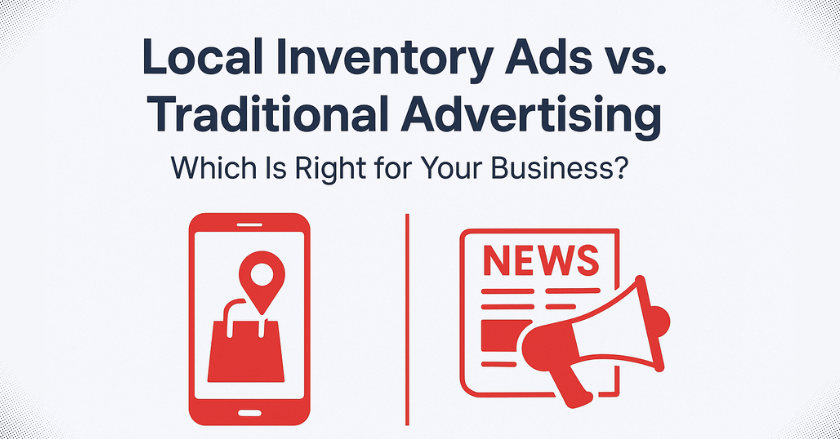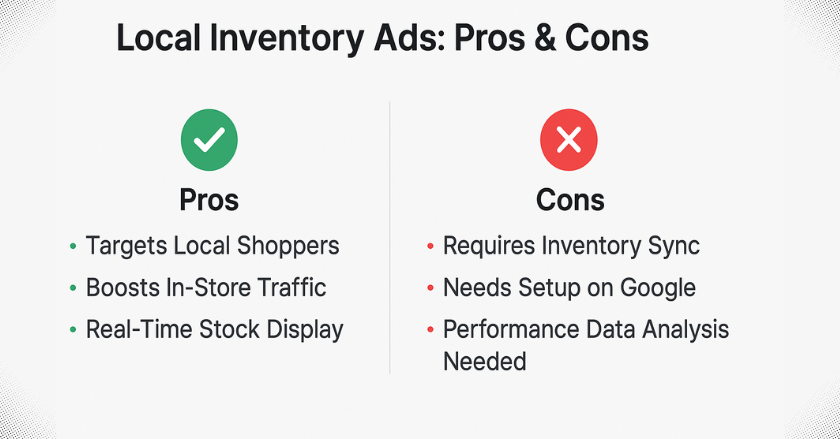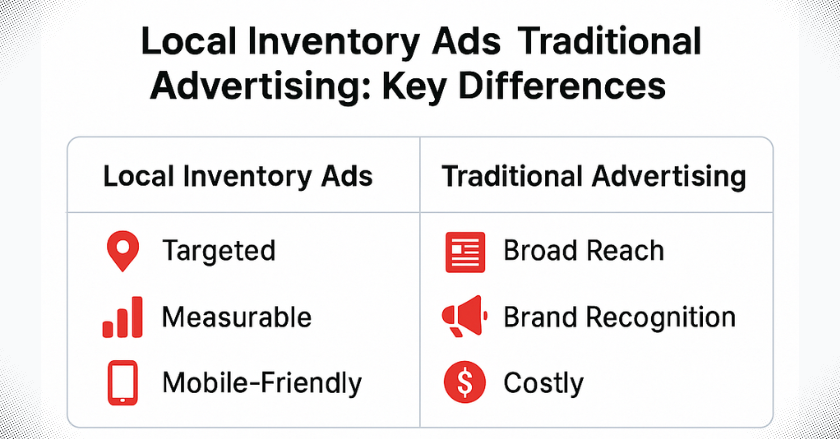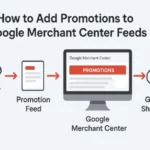
The pace at which businesses are growing and consumers can research reviews and products online before making a purchase is indeed mesmerizing. However, this presents a unique challenge in the form of competition when it comes to product visibility. Local Inventory Ads and Traditional Advertising are the right way to try and garner a share of the marketing dollar.
In this blog post, we will analyze both these methods, their advantages, and disadvantages to help you choose the better of the two. There is enormous potential in advertising, whether it is for physical stores or even online e-commerce brands. Don’t worry, our specialists will assist you in increasing your advertising effectiveness so that your every rupee spent is justified.
While most ads have remained unchanged over the years, local inventory ads are exciting in a new way by targeting retailers looking at shoppers around them. But which one is right for your business? Allow us to do this as we take a look at each one of these strategies in depth and help you make up your mind on the best way to promote what you are selling or the services you provide. With clear goals on boosting in-store visits or the brand’s presence through multiple mediums, clarity on these ad subject matters will help achieve those objectives.
What are Local Inventory Ads?
Local Inventory Ads help businesses make the transition from online browsing to in-store shopping. Pretty much, these ads emphasize items sold by stores located in close proximity to customers so they can be easily seen and purchased when needed.
Local Inventory Ads are designed to increase the number of people who visit a brick-and-mortar store. Due to local inventory ads presenting appealing images and local inventory content. These ads are more attractive to people who otherwise buy only through e-commerce.
In what way(s) do they function? In response to a user search, Local Inventory Ads can be displayed as an addition to Google’s search results relevant to the item searched for. This way, it is possible to quickly find out whether a certain item is in stock at a shop and where it is located. The idea is to deliver on the promise of making it easy for people who go online to shop to access a physical store efficiently.
What is the core aim of Local Inventory Ads?
Local Inventory Ads are a subset of advertising solutions that seek to integrate local consumers with local shops. They allow businesses to display their products and stock availability within their adverts.
The most important objective of such commercials is to motivate consumers to walk into the stores and make purchases. At the time, internet users are looking for particular goods. Local Inventory Ads let them know of the existence of such goods at nearby stores. This narrows the gap between searching for an item and shopping for it at a store.
With these ads embedded in the invoice, the user is required to make a payment for the ad unit that contains relevant product information, such as where the product is located, its price, and stock status. The satisfaction of having an inventory synced with the advertisement horizon improves the buying experience and allows sellers to make more sales as the temptation of purchasing readily available products is very high.
How do they work?
Local Inventory Ads work by showing your items to potential customers who are searching for them online. These advertisements are displayed on search engine results pages in a prominent position when a person is looking for a product that you have in stock. These sources depend on the real-time inventory data kept in your retail shop’s database. It means that when items exist in stock, they can be displayed right away. Customers not only see the goods but also their prices and the furthest distance to the closest one.
These ads redirect back to your website or your Google My Business page. They are readily able to get directions to the store if they need it or learn more about the item or the store before they even make a purchase.
Moreover, Local Inventory Ads are also very mobile-friendly. It makes it possible for busy shoppers to get information on local inventory availability. While they are out and about, making their shopping experience especially pleasant. Striking images and simple phrases installed with clear instructions on what to do next are used to promote foot traffic straight to your business.
Pros and Cons of LIA

Ads are utilized differently because Local Inventory Ads use a more dynamic perspective that works awesome for places with physical presence. By far, one of their great highlighting advantages is the affordability. If it is after the budget, once again, then it is like traditional advertisements, but if it is through GPS, then local inventory campaigns are economically useful for reaching out to new clients. It improves brand awareness role since it brings out another advantage, which is how ads boost the brand specifically.
Lastly, there are lots of advantages that come with measurable results, such as CTR and engagement, which are great. However, the downside of this data can also be tiresome. In the thought of analyzing performance metrics, it requires one to invest time and knowledge, which rarely all small business owners have and are ready to invest. Cost impact analysis is a significant and enormous disciplinary area.
When you target consumers who have a clear intent, you waste less on advertising and improve ROI. It’s a smart way to reach shoppers at the precise moment when they are likely to make a purchase. They do not have to overspend but rather deploy their resources judiciously and get the desired deliverables.
Targeted audience
Targeted audiences are of utmost importance in making enterprises manage their advertising campaigns efficiently. Knowing your customer enables you to craft messages that cut deep.
- Local inventory ads are specifically aimed at potential customers in your state or area. This means that you can save your marketing costs and reach individuals searching for the products you sell in the local area.
- This kind of accuracy saves resources and improves engagement. Instead of casting a wide net, you’re fishing where the fish are biting.
This kind of strategy improves conversion rates and makes clients more loyal to the business. When customers are given relevant offers designed specifically for them, it is perceived as a personalized shopping experience that is hard to forget.
Quantifiable outcome
The quantifiable outcome changes the way business is done for the better. Local inventory ads give information that is current and measurable, making it effortless to evaluate results.
Quantifiable metrics such as the number of clicks, the Number of impressions, and the number of conversions help in making decisions. You can tell what products yield sales and need which strategies.
Achieving this degree of understanding is almost impossible with advertising through traditional media. Print or Television advertisements may reach thousands of people, but they do not have the depth of analysis that local inventory ads provide.
Actual campaigns should be directed not by assumptions or approximations but by what the visitors are doing. This degree of accuracy not only cuts costs, but it also increases efficiency over time.
Because the market is moving very quickly today, knowing what works gives businesses the ability to outperform their rivals and fulfill customer demands more precisely.
Traditional Advertising Methods
Traditional advertising methods have always served as the pillar of marketing for quite a long time. They include several channels that differ in the message and how the audience was reached.
Print advertising has never ceased to exist and continues to be beneficial, which explains its use for centuries now by different philanthropies and companies alike. Websites, magazines, and newspapers are just a few examples that employ the use of print advertising. Print ads can reach potential customers most effectively if all rules are followed and they are creatively designed.
The most reassuring feature would be the standalone aspect of a printed ad in any form. A significant number of people would argue that words printed on paper tend to remain in the minds of people significantly more than any form of advertising on screens. That essentially explains why companies use print advertisements for longer periods to garner repeated exposure.
Despite rapid technological advancement, there is still a need for print advertising, as they have its advantages. That cannot simply be replicated, and as such, they will continue to be a useful aspect of marketing. Many businesses still engage in print advertising to enable them to reach out and be able to forge meaningful connections with their target audience.
But measuring success is not easy. In contrast to online platforms, where the number of clicks and conversions is frequently tracked, print is much more dependent on brand visibility and conversation around it. Shifting the focus to the digital sphere has left some believing that the importance of print advertising has diminished. Despite this, print advertising is still quite useful for companies in need of community presence and trust.
TV and radio ads
TV and radio ads are the standard for marketing businesses and reaching out to clients. Marketing and achieving a large target audience in a short period is essentially easy using these marketing strategies.
- The process of watching the ads through television is thrilling to viewers, while the radio follows with rhythmic jingles to retain the listener even after the ad is over. They both use feelings to create brands, and the creativity in either of these makes it easy and effective to construct a brand.
- But creating those ads is not only time-consuming, it is costly too. Marketing towards an audience requires money, and high-quality production is expensive. In this regard, traditional media needs to be planned strategically.
In addition, it is somewhat difficult to determine the actual influence of TV and radio campaigns as there is little or no analytical data, as is the case with digital channels. Companies typically have a hard time finding live metrics and have to settle for either sales data or surveys for their success metrics.
Direct mail
Direct mail is a massive tool that is used in sending letters, brochures, and catalogs to potential buyers. It has always been a potent marketing tool that enables businesses to reach people and extend a more personal touch to potential clients.
- It can also reach certain interests or geographic regions. This appeals especially to brands to have an interest in sending out messages that have meaning, as every piece sent out has greater relevance than sending minor pieces of mail.
Of course, this also makes it a more expensive kind of advertising. Companies should be willing to set aside resources for designing pieces and building mailing lists. However, brands willing to take that risk need only the right strategy as they could achieve remarkable returns from the advertising method.
Pros and Cons of Traditional Advertising
Traditional advertisement holds a wide coverage; it is characterized by printing, radio, and television. Such frequency in both breeches starts a significant impact on brand awareness and growth, as such lines increase visibility. Cost is one of the impacts on traditional advertisers. Making a high-quality video or a large-scale page magazine will take cost. This is especially a budget pressure for small businesses.
Another difficulty is the measurement of success factors. Traditional advertising does not have a successful record like digital campaigns because they are not common when an advert is placed. Moreover, the level of Wen that an audience interacts with promotional content differs depending on the medium. Some people may seize the pleasure of viewing a television advertisement during their favorite program. While others may feel overwhelmed when their programs are full of interruptions and advertisement blockbusters.
Wide reach
Advertising on television, radio, and in newspapers is reaching a wider audience than most digital strategies to suit and meet the goals that go in line with the business. Think about the influence of television advertisements when it comes to prime time slots. It creates an opportunity for brands to penetrate multiple households across the country as millions switch on their television every minute. Radio is equally as helpful as it has a wide audience, from urban places to rural ones.
Even print media has not been left behind and still has its fair share of audiences. Newspapers and magazines are as effective as having a product in the hands of your target customers, advertising your brand while reminding them to find out more about you. On the downside, this strategy can be effective for penetrating potential customers in large-scale efforts. It is usually very costly, and this is something that every organization has to balance with any marketing objectives they have established.
Brand recognition
Brand recognition encompasses an important part of any advertising strategy. It describes the extent to which consumers can look at your brand and the symbol of a lion among its many rivals. This kind of recognition often leads to confidence, which is one of the core factors in the purchase process.
- Once customers can associate a brand with its company, they become more willing to deal with it. When people are familiar with something, they will more likely become loyal customers over time. This kind of recognition has often been developed through TV ads, which are print advertisements that have always been effective in the past.
- On the other hand, the drawback is the cost and the associated resources for these channels. Not every business could bear the cost of a wider reach.
Local Inventory Ads do not have the instant visibility of traditional means. However, they offer controlled touchpoints with intended local consumers looking for defined products. This kind of fetches familiarity without excessive reliance on mass advertising.
High prices
Conventional means of advertising generally have high financial outlays. For instance, print media involves advertisements in magazines that can be very costly for prime sites. Most TV and radio spots do come at quite a significant cost to one’s budget. They include production, airtime, and any personnel used. These would be unreasonable for small businesses intending to tap into such media types.
- Direct mail marketing is yet another one of those costs. The cost of these campaigns is a function of printing, postage, and design. The high coverage costs undermine the company’s efforts in trying to reach its audience. Companies might end up having to spend more than they have earned.
In all other instances, however, reaching customers has not been possible without huge costs. There is, however, a limitation with Local Inventory Ads in terms of coverage. A shift is also witnessed from general coverage to targeted engagement at a much lower cost than traditional marketing methods.

Examples of Successful Local Inventory Ads from Case Studies
Imagine a local shoe retailer that has participated in Local School Ads for the back-to-school season. They then display stock availability so that local customers who are looking for the styles can come in. This strategy ended up increasing foot traffic by 30% and sales by 25%. The aimed strategy was effective, as it addressed customers who were willing to make a purchase.
- On the contrary, a regional restaurant went for a traditional advertising route through beautiful-looking print ads in lifestyle magazines. This increased their brand presence, but it was hard to trace back the real returns. Although there are very high expenses, they managed to have a slight increase in the reservations made.
These different strategies exemplify how businesses can experiment with social media in different ways even as they work around the constraints of the older forms of advertising. Each case allows the organization to maximize growth in revenue through customer engagement based on the tactics employed. Such outcomes are critical in today’s environment as companies seek new avenues to market their products or services.
Selecting the Most Effective Advertising Approach for Your Business
Choosing the most suitable advertising strategy needs analysis of several factors, in this case, quite a number. First is your funds available. What amount can be set aside to facilitate your marketing efforts? This will determine the viability of local inventory ads or traditional methods.
Next, consider your target customer. Are they into online shopping or are they still using printed media? It is important to identify where your customers are to place ads effectively. But also, there is no need to cast a blind eye towards what you are advertising. Videos are great for showcasing some products, while print advertising could take some products to the next level.
Finally, think about how soon you want to see results. Local inventory ads have the advantage of quick visibility, unlike the more traditional means, which may take time before a response is realized. These factors need to be harmonized to enable you to adopt strategies that fit your business objectives and customers’ needs.
Factors to consider (budget, target audience, product/service)
- All you need is a Local Inventory Ads budget because that’s all you are going to have in hand. Budgets should be set such that they allow the freedom to invest in advertising without unnecessary constraints on attaining a profit.
- Then, think about your audience. Who are they? Where do they go? What are their age groups? From the analysis, the target audience can be easily determined, and a suitable way planned to reach them. Local Inventory Ads focus on well-defined audiences targeting customers when they need them.
- Finally, consider the role of your product or service in this discussion. Is it something people will want to see before they buy? If the answer is yes, then local ads may be more appropriate than other campaigns, which do not promote foot traffic. Most of these elements will, in their ways, point to the best ad preparation strategy that will bring about circumstances favorable for success.





